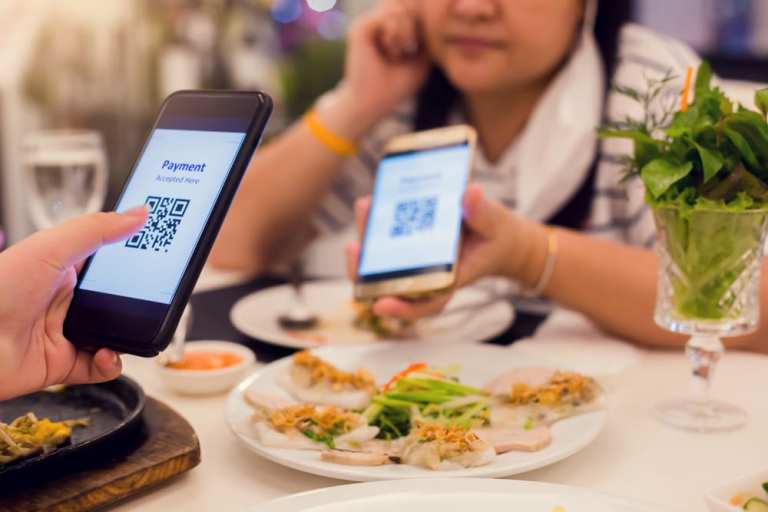QR codes have long been popular for payments, information access, Wi-Fi logins, counterfeit detection and a host of other services, but the technology has relatively humble beginnings.
It was developed for the automotive industry in Japan in 1994 with the intended purpose of tracking vehicles during manufacturing, originating as little more than a sophisticated bar code with a design allegedly influenced by the black and white pieces of the board game Go. Smartphone-based QR code scanners’ introduction in the latter half of the 2000s brought about a renaissance for the codes, allowing consumers to scan them with devices they almost always had on hand.
The codes quickly became commonplace in the business world as a way of offering consumers instant information, with users being routed to specific websites after scanning the codes with their phones. The first QR code-enabled payment was developed in China in 2011, and the method has since taken the financial world — especially in Asia — by storm.
The codes have witnessed widely varying adoption rates in different parts the world, however, despite their plethora of use cases in the payments field and beyond. The U.S. in particular has been slower than many countries in adopting QR payments, even though the method provides numerous benefits over physical cards and cash.
The following Deep Dive explores the growth of QR code adoption around the globe and what U.S. merchants must do to bolster usage.
QR Codes’ Exploding Popularity In Asia
QR codes have seen the highest adoption rates in Asia, where they were created. China, for example, is a world leader in QR code usage, with residents leveraging them for everything from saving spots in cafeteria lines to monitoring individuals’ health. They are even being used to set up dates at bars, with establishments installing large TV screens on which users can display messages and solicitations. Bar patrons can scan QR codes at the top of the screen to view specific users’ messages, get access to their phone numbers and potentially arrange more private meetings.
Half of all Chinese consumers scan QR codes several times per week for all sorts of reasons, but payments represent the most popular use case. Scan-to-pay transactions within the nation have grown 15-fold over the past three years, hitting 9.6 trillion yuan ($1.5 trillion) in the fourth quarter of 2019 alone. The pandemic has only intensified the QR code market, regardless of the current economic downturn, with the QR code economy increasing by 26 percent in 2020’s early months compared to the same period the year prior.
QR code usage is commonplace across the rest of Asia, but the region’s other countries are currently competing for second place. Forty percent of India’s population use QR codes, while 27 percent of Vietnamese and 23 percent of Thai consumers do the same. Singapore, South Korea and the Philippines also see robust adoption, with each having more than 15 percent of its population using QR codes for payments.
Consumers in these countries are far outpacing their American counterparts in QR code adoption, and while the technology’s usage has seen a notable bump in the U.S. due to the ongoing pandemic, it still falls short of its popularity in Asia. Many merchants across various sectors in the U.S. are working to change that, however.
How U.S. Merchants Are Driving Adoption
The ongoing pandemic has been a game-changer for eCommerce in the U.S., with the health crisis having widespread effects on consumers’ attitudes toward cash. About 50 percent of Americans leveraged contactless payments at least once in July due to the perceived risk of infection from handling cash, and one-third of U.S. consumers said that contactless solutions were their go-to purchasing methods by October. QR codes seem like a natural fit for these payments but have witnessed relatively modest adoption rates, with just 11 million U.S. households expected to have scanned QR codes by the end of 2021.
Merchants, restaurants and other businesses across the U.S. have taken steps to drive greater QR code adoption, however. PayPal waived all QR code-based payment fees in May, for example, and pharmacy chain CVS introduced QR code-powered contactless payments at 8,200 of its U.S. stores to incentivize customers’ use of the method.
One field in which QR codes have gained a significant foothold is the restaurant industry, where the technology is being deployed not only for contactless payments but also for contactless menu viewing and ordering. These tools allow customers and staff to spend less time interacting with one another, thus reducing their risk of infection, and are expected to remain in use even after the pandemic ends on account of their glowing customer reviews.
The ongoing pandemic has given a boost to the QR code industry in the U.S., but it remains to be seen how widespread the technology will be once social distancing becomes less critical. Merchants, restaurants and other businesses must continue to implement seamless and convenient QR code innovations to boost the technology’s use among American consumers now and in the future.

